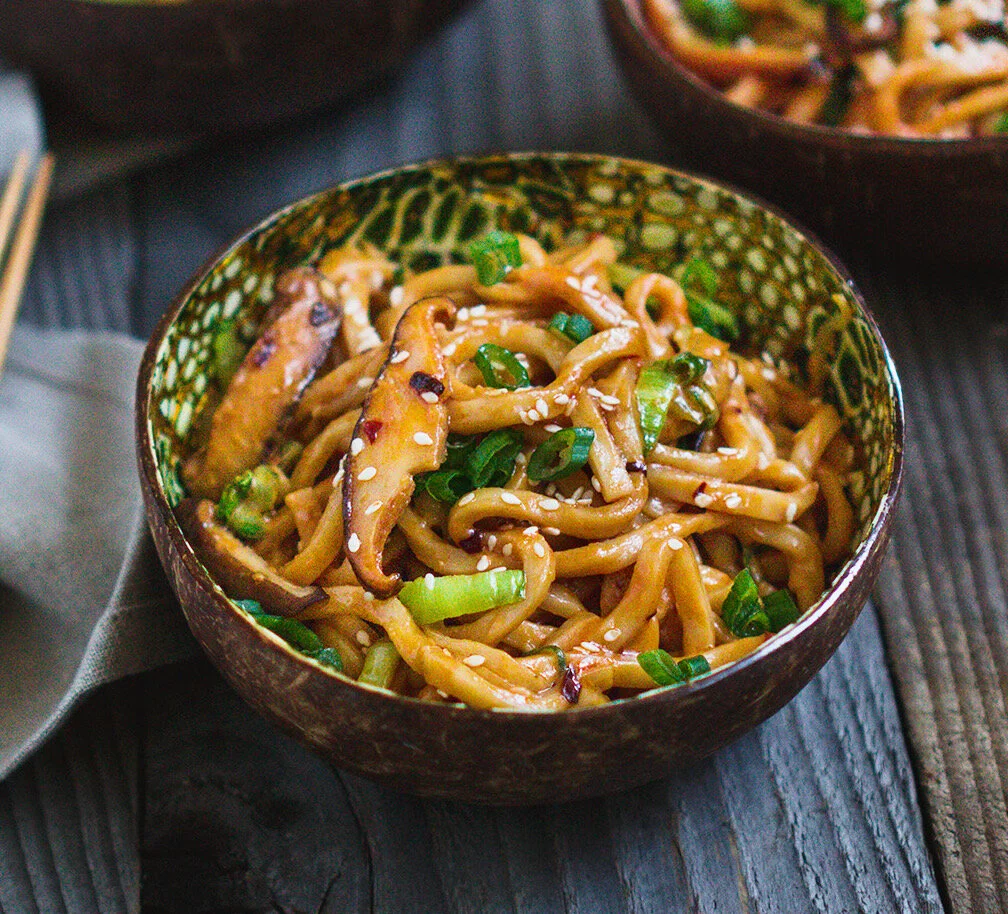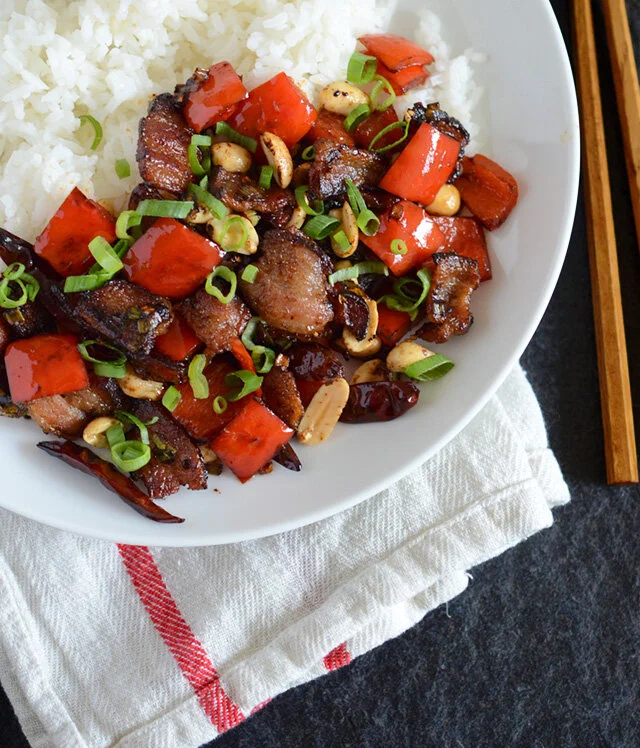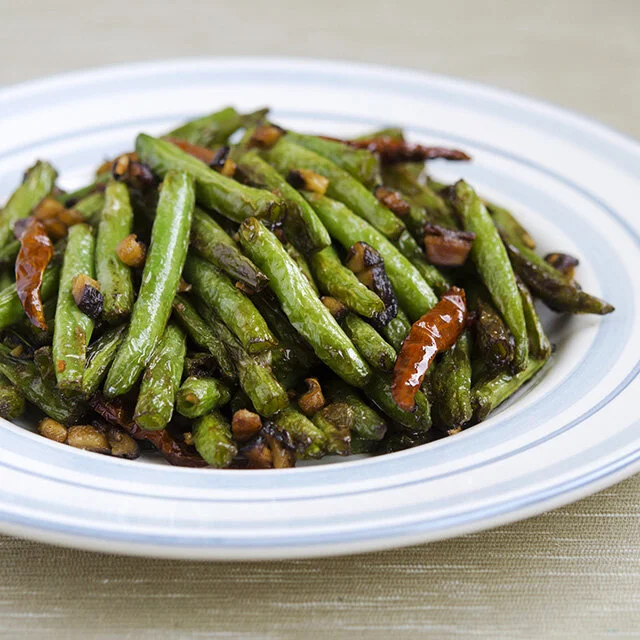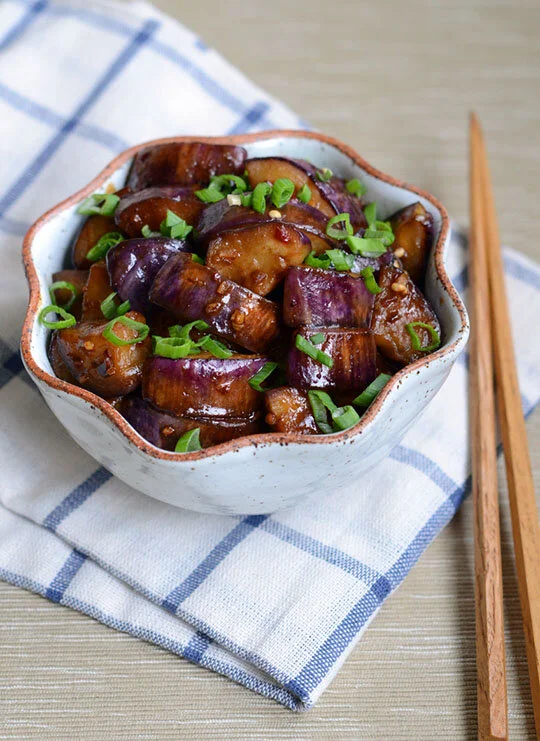These noodles are coated with a lip-smacking peanut sauce infused with Sichuan chili oil. They‘re so delicious I’ve never had any leftovers.
Read MoreMy vegan take on traditional Sichuan dan dan noodles is simple and packed with flavor.
Read MoreA delicious, vegan Kung Pao dish that is filling and packed with smoky heat.
Read MoreSichuan mapo tofu traditionally has pork for flavoring, but there is a lesser-known vegetarian version called mala tofu.
Read MoreWhat about proteins can you use with a kung pao sauce? Bacon, for one.
Read MoreDried-fried green beans is one of my favorite side dishes to order in Sichuan restaurants. They're crisp and well-cooked without being bland.
Read MoreIf I had to make a list of my top favorite comfort foods of all time, mapo tofu would be among the top 10.
Read MoreSichuan eggplant is the perfect vegetarian entree or side dish for anyone who likes earthy, garlicky, and spicy flavors.
Read MoreRed-cooked beef is one of those dishes that is just made for the winter. This Chinese beef stew — made by simmering well-marbled beef in a combination of soy sauce, cinnamon, star anise, tangerine peel, and chilies — is as aromatic and delicious as it sounds.
Plus, the bubbling action and warmth in the kitchen while you make this dish is a huge plus when it's 19 degrees F out and your radiator isn't working as well as it should.
Some of you may have tried making red-cooked pork before from this site. My method for red-cooked beef is similar, with some key differences. One big difference is the addition of dried tangerine peel. You can choose to include it or not, but I find that orange flavors pair so well with beef, and adds such a wonderful citrus fragrance to the stew, that I can't pass it up.
You can buy tangerine peel in any Chinese market, but it's also easy to make your own at home. Just peel a tangerine (reserving the insides for a snack!), rip the peel into large pieces, and keep the pieces on a windowsill or another cool, dry spot for 2 to 3 days. Or, to dry the peels on short notice, bake the peels in a 200 degree F oven for about 60 to 70 minutes, until they dry up and look like the peels in the photo above.
Read MoreWhat a crazy two weeks. Here in the Northeast, many areas are still recovering from Hurricane Sandy. and now we've been hit with a Nor'easter. Right now it's snowing and raining at the same time, which makes me want to just stay inside and make something extra-comforting, like chicken noodle soup.
I first experimented with making Sichuan-style chicken noodle soup 3 years ago. And it's no less of a favorite comfort food dish now.
Rather than the American version flavored with bay leaf and thyme, I decided to make a Sichuan-style broth with star anise, cinnamon, tangerine peel, and Sichuan pepper. (There will be a mild tingle from the peppercorn, to jazz things up.) The best part: you can shred leftover roast chicken, itself a cost-saver, and add it to the soup at the last minute. The simmering anise and cinnamon will make your kitchen smell wondering. And slurping the steamy chicken noodle soup will get you through these chilly wintry days.
This recipe for Sichuan Kung Pao Chicken is super easy, much better than takeout, and will become a go-to entree for your dinner table.
Read MoreFor the past few days, ever since daylight savings, I've been thinking about winters back in Massachusetts. When I was younger, around this time of year, the old Jordan Marsh department store in Boston (now a Macy's) would set up the "Enchanted Village", an almost-over-the-top holiday wonderland that took up a whole floor of the building and drew in hoards of visitors with its lavish window displays. There were mechanical teddy bears in Santa hats waving at you. Toy trains chugging over and under snow-capped plastic mountains in dizzying figure eights. Endless repetition of Jingle Bell Rock and other holiday standards. Parents and kids and babies in strollers coming from all directions. And I went back year after year, loving every single minute.
(To this day, I'm a huge sucker for Christmas displays, even though my Sunday school education and church-going ended somewhere around third grade.)
And en route from Jordan Marsh, next to the Salvation Army bell ringers, there would inevitably be a guy selling fresh roasted chestnuts. I'd share a bag with whoever I was with, either my mom or aunt or a friend. Munching on the chestnuts, I'd also start humming the opening lines of The Christmas Song to myself, even the nuts weren't actually roasted, as the song goes, over an open fire.
Read MoreDan dan noodles is one of those quintessential Sichuan dishes that you must try at least once if you're a fan of anything spicy. The chili-laced vinegar and sesame sauce is quite possibly one of the finest sauces that ground pork or beef can ever be cooked with.
Now, if you were to have dan dan noodles in Sichuan province, the noodles would come swimming in a chili-laced broth that is almost impossible for mortals (non-Sichuan-natives) to slurp. I like to do a less saucy version that tones the heat down slightly while still maintaining flavor. The noodles in this recipe are spicy enough for someone who doesn't mind a little heat in their food. But please feel free to adjust the amount of chili oil to your preferences. And slurping is, of course, encouraged.
The first time I ever had dan dan mian was years ago in New York's East Village. It was one of those insanely hot and muggy July days, and my friend Shar and I were walking on St. Mark's Place, sweaty even in tank tops and skirts.
"Where do you want to have lunch?," I asked.
"Anywhere with AC," was the reply.
Read MoreOne of the things I missed the most while traveling was having a standard stock of kitchenware. When you're bopping around from city to city, and readjusting to a new kitchen every few months, you're not going to have all necessary tools at your disposal. Especially the super heavy items, like a mortar and pestle. I went almost three years without one. If you cook for a living, that should be a crime.
I used a mortar and pestle whenever I could, like while working at The Hutong in Beijing, but for most of the last peripapetic 3 years I mostly made do with ground spices. I just couldn't justify moving around 10-pound stone objects to every kitchen I used. (Nevermind that I had at least 5 times the weight in cookbooks.) But now, ever since moving home, I've been crushing spices like a fanatic.
For anyone who craves the numbingness of Sichuan peppercorn, the whole spice will always be more satisfying than the pre-ground variety. If you have to use "crack" to describe any food item, use it for Sichuan peppercorn, instead of Momofuku desserts. So, when faced with a mountain of shimeji, king trumpet, and large shiitake mushrooms (went a little overboard at Whole Foods), I decided to sort of recreate a wild mushroom stir-fry from a trip last year to Chengdu.
Read MoreI made this for dinner early last week. By the time Jacob and I were halfway done, we were already sniffling, with sweat beads ready to form. Even in the pantheon of Sichuan cuisine, this is one helluva spicy dish.
Shuizhu niurou (水煮牛肉) is translated literally into English as "water-boiled beef", a rather benign name for such a potent tongue-burning dish. Restaurant versions usually come in a clay or iron pot, with about 100 chilis foating on the surface of the bright red broth, and a few pieces of beef poking through. It could more aptly be named "water-boiled chilis with beef garnish." The fish version can be equally alarming. But for spice fiends and native Sichuanese, this fiery dish is pure delicious comfort food.
Fortunately, the version I made at home is manageable, though just barely. The nice part is that if you don't care about how impressively red the broth is, you can adjust the spiciness to your tolerance level, by 1) using less chili bean sauce, or 2) leaving the dried chili peppers whole instead of chopping them up and unleashing the beastly seeds.
Read More








